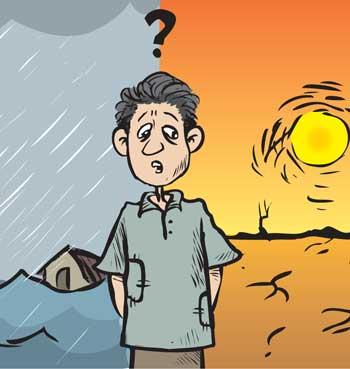06 Aug 2019 - {{hitsCtrl.values.hits}}
 The climate forecast projects that the dry zone of Sri Lanka, which receive an annual rainfall of less than seventy-five inches, is to get drier in the years to come. On the other hand, it has already been witnessed that the annual rainfall in the wet zone has been on the rise during the past few years. This means while the dry zone is going to get drier the wet zone is going to be wetter, with more floods, earthslips, epidemics and other related catastrophes.
The climate forecast projects that the dry zone of Sri Lanka, which receive an annual rainfall of less than seventy-five inches, is to get drier in the years to come. On the other hand, it has already been witnessed that the annual rainfall in the wet zone has been on the rise during the past few years. This means while the dry zone is going to get drier the wet zone is going to be wetter, with more floods, earthslips, epidemics and other related catastrophes.
The Department of Irrigation has suggested constructing reservoirs in the wet zone to help mitigate incidence of floods along the Kelani River. Two projects have been proposed, one in Deraniyagala and another in Yatiyantota. It was revealed that both have been shelved due to public protests backed by local politicians. Besides controlling floods the projects were also aimed at providing drinking water to the entire Western Province.
As to what extent should a government bow down to public protests when addressing a critical, national issue like this, is a concern. For instance, last year’s flash floods in Kelani, Kalu, Gin and Nilwala rivers killed 21 people, left another 23 missing and displaced about 150,000 people. Ratnapura district received 122.7mm rainfall within 24 hours.
Given the human cost and economic cost of such a disaster, which has of late become an annual if not bi-annual occurrence, one wonders as to whether there shouldn’t be stricter laws regarding the acquisition of land for such urgent projects.
Last year the Ministry of Megapolis and Western Development proposed the establishment of a River Basin Authority (RBA) to control and develop the country’s 103 river basins. The purpose was multi-purpose development of rivers which included creating reservoirs, diverting waters in wet zone rivers to dry zone, controlling floods and many other purposes. Diverting some of the floodwaters to Kurunegala and Puttalam and Gin Ganga to the South and Moneragala were among the proposals.
It is estimated that annually an average of 5.5 billion cubic metres of water from the Kelani River flows to the sea. While this would be considered an invaluable resource by any other nation, it’s pathetic to see projects aimed at maximizing the use of this water resource and mitigating the perennial flood issue coming to an end due to public protests. The suspension of the plan has been the Department of Irrigation building a river bund along the Kelani River from Hanwella to the river mouth. However, this would not help address the impending drinking water problem in the western province. Another country may have by now gone ahead with the proposed plan despite public protests and provided the displaced with alternative land, accommodation and compensation.
This does not mean that force should be used as a means of operation for each and every project in Sri Lanka. For instance, it’s true that there are quite a few projects, motivated by some fancy, myopic vision or kickbacks for respective politicians, have deprived valuable lands belonging to the public. However, constructing reservoirs to fight floods and providing drinking water is a national necessity. It’s time that the government put its foot down.
It is estimated that annually an average of 5.5 billion cubic metres of water from the Kelani River flows to the sea
25 Oct 2024 6 hours ago
25 Oct 2024 9 hours ago
25 Oct 2024 9 hours ago
25 Oct 2024 25 Oct 2024
25 Oct 2024 25 Oct 2024